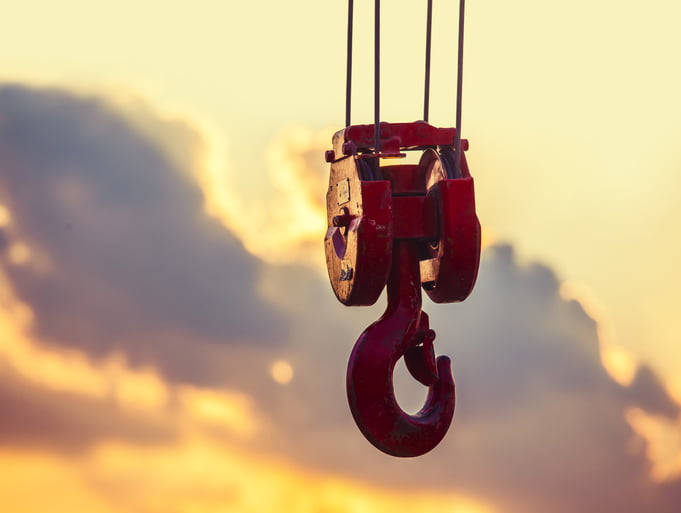Cranes and rigging are an important compenent of the construction process. They play a pivotal role in lifting and positioning massive loads with precision. However, these giant machineries come with a number of safety hazards that worksites should address.
In this blog, we will explore the crane and rigging safety procedures and how construction sites can protect workers from potential accidents.
Let’s jump in.
How Does A Crane Work?
Cranes are heavy machines that use to lift and shift objects from one place to another. Crane uses hoist rope, cable ropes, and sheaves to connect with loads for transportation. Crane design has evolved to satisfy the needs of a wide range of industrial applications, and modern cranes frequently coordinate simple components to perform complicated lifting tasks – sometimes in hazardous situations for humans.
Different types of cranes employ for specific tasks. These types include:
- Telescopic Crane.
- Mobile Cranes.
- Truck Mounted Crane.
- Tower Crane.
- Rough Terrain Crane.
- Overhead Crane.
- Bridge Crane.
- Crawler Crane.
- Aerial Crane.
- Hydraulic Crane.
- Carry Deck Crane.
- Floating Crane.
- Bulk-handling Crane.
- Hammerhead Crane.
- Stacker Crane.
- Railroad Crane.
- Harbor Cranes.
- Level Luffing Crane.
Who Is Responsible For Crane Safety?
It requires a vigilant supervisor, attentive operator, and other workers to make sure that cranes work safely. The crane is an extremely heavity and sizable machinery. This means that anything going wrong can have disastrous consequences. While a good chunk of the responsibility lies with the supervisor, the safety of crane operations is wthin the hand of the operations because they are behind the machine.
As the weight lifts from the ground, the crane operator is in charge of the safety. When operators have reason to suspect the lift is dangerous or unsafe, they must refuse to proceed until the problem is noticed by the supervisor. The professional behind the machine should be aware of the crane operator safety procedures.
How To Ensure A Safe Crane Usage?
It is estimated that Crane Inspection and Certification Bureau that 90% of crane accidents happend due to human error. Supervisors and operative must work together and develop a strategy so nothing goes wrong during the crane work.
1. Responsibilties Crane Operators
Here is what crane operators should do to reduce the chance of accidents while operating these machineries.
- Equipment Suitability: Ensure that the chosen crane is suitable for the specific task at the construction site.
- Maintenance: Confirm that the crane is well-maintained and in proper working condition before any lifting and transferring operations.
- Knowledge and Training: Acquire and apply comprehensive knowledge of the crane, including its model, characteristics, functions, and limitations, as specified in the operating manual.
- Load Capacity: Refer to the crane load chart, which provides vital information on the crane’s capacity and any safety warnings or considerations for different configurations.
- Inspection and Maintenance: Adhere to strict inspection and maintenance procedures, documenting all actions in a logbook.
- Site Preparation: Verify that the site is adequately prepared for crane operations and that all plans and lift requirements are reviewed with site supervision.
- Safe Operation: Operate the crane in a smooth, controlled, and safe manner, adjusting load weight as needed to account for factors that may reduce crane capacity.
- Shutdown and Security: Properly shut down and secure the crane when leaving it unattended.
2. For Site Supervisors
On the side of site supervisors, here are few things that must be ensured:
- Oversight: Supervise all crane-related activities on the construction site.
- Load Management: Determine the correct load weight and radius, and communicate this information to the crane operator.
- Rigging Crew: Ensure the rigging crew is experienced and capable of handling various aspects of rigging, including weight estimation, distance judgment, and equipment selection.
- Safety Oversight: Supervise the rigging crew to ensure the load is rigged safely and securely.
- Signalers: Designate signalers and ensure they can effectively communicate with the crane operator, especially in cases where other forms of communication are not possible.
- Safety Measures: Prioritize the safety of the rigging crew and all personnel affected by crane operations.
- Area Control: Control the movement of all personnel in the vicinity of the lift to maintain a safe and clear work environment.
- Powerline Precautions: Enforce precautions when the lift is near powerlines to prevent accidents.
- Worker Awareness: Ensure that all workers are aware of their responsibilities in maintaining the safety of each lift.
Preventing Crane Damage
It is a necessary task to know about the precaution of any danger. It is estimated that a number of the crane accidents happen due to mistakes during setting or dismantling the cranes on site. That is why it is important to examine the crane before, ongoing, and after conditions of the operations.

Operators and maintance professionals should check lubrications, alignment and test the safety system before delpoying the crane at the construction site. This proactive approach not only safeguards the well-being of personnel but also extends the service life of the equipment.
What is Rigging Safety?
Rigging is a method of shifting and lifting objects from one place to another with the help of cranes. The rigger is a device, which connected the crane with the load. Rigging is also a significant part of cranes operations because a simple mistake can become a disaster. Riggers have to plan operations before practically doing work on site. OSHA has several protocols for crane safety and basic rigging to avoid disasters at worksites.
- Supervisors and riggers have complete training and knowledge of rigging.
- All the weight needs to monitor before placing them on the crane and using specific rigging. The load that is more than the rigging capacity is only placed for testing purposes.
- Before each operation or lift, determine the total weight of the object.
- Every part of the crane, hoisting, and rigging equipment should be checked properly before use.
- Immediately, stop the operation when any chances of accidents appear. Accidents can cause by weather conditions like extreme cold, windy weather, extreme sunlight, then any mechanical problem during work.
- Always use the right rigging equipment for each job. In the rigging training, workers use the right equipment for the right weight. These tools include shackles, blocks, pulleys, rigging hooks, wire ropes, synthetic slings, and more.
- It is necessary to understand that working with objects like these is hazardous. The risk is not only the weight that can fall from the height which it falls on workers. It can crush and take the life of workers on the site.
- To avoid all of it, employers and employees need training, planning, and providing safe lifts each time.
All the people who work on these sites with heavy machinery need to have professional training. And full awareness of the hazards these machines can make. Familiarity with these things can save lives and money.
Conclusion
Cranes and rigging are integral to construction but come with safety risks. It’s vital for everyone on the site to prioritize safety. Crane operators and supervisors must be diligent and aware all the surrounding workers of potential hazards.
To keep yourself safe as a consturction worker and learn about crane and rigging safety, you can enroll in OSHA 10-hour construction course. Similarly, those in the supervisory roll and have the responsibility to create a culture of safety should start OSHA 30-hour construction training. These courses provide crucial knowledge and skills to keep construction sites safe. Your commitment to safety can save lives and enhance project success. Take action today.



